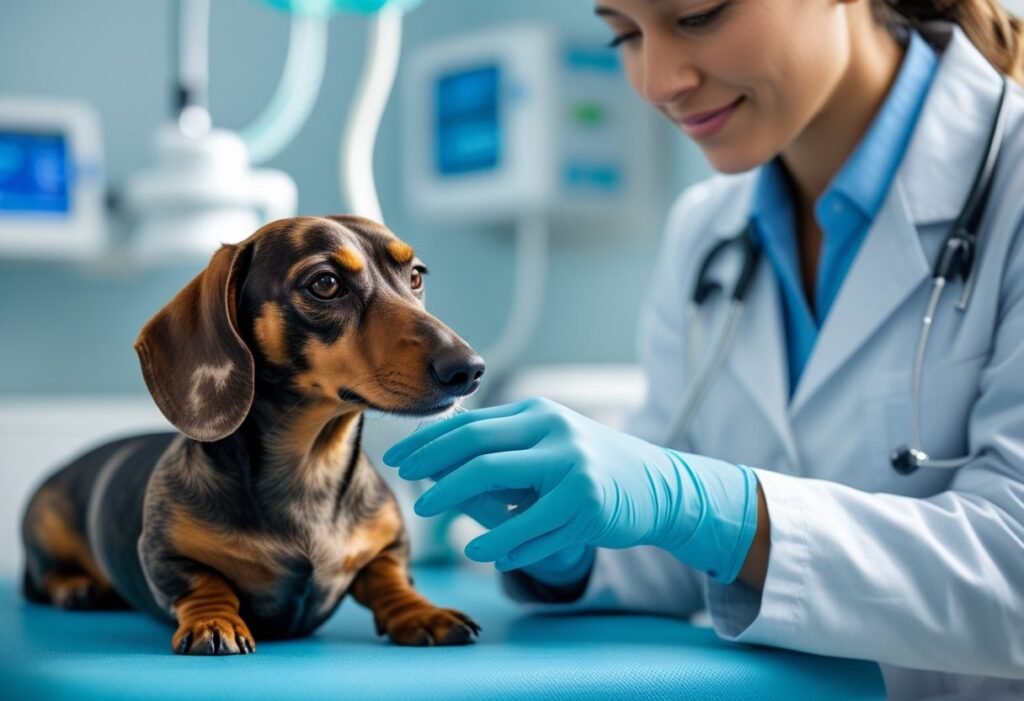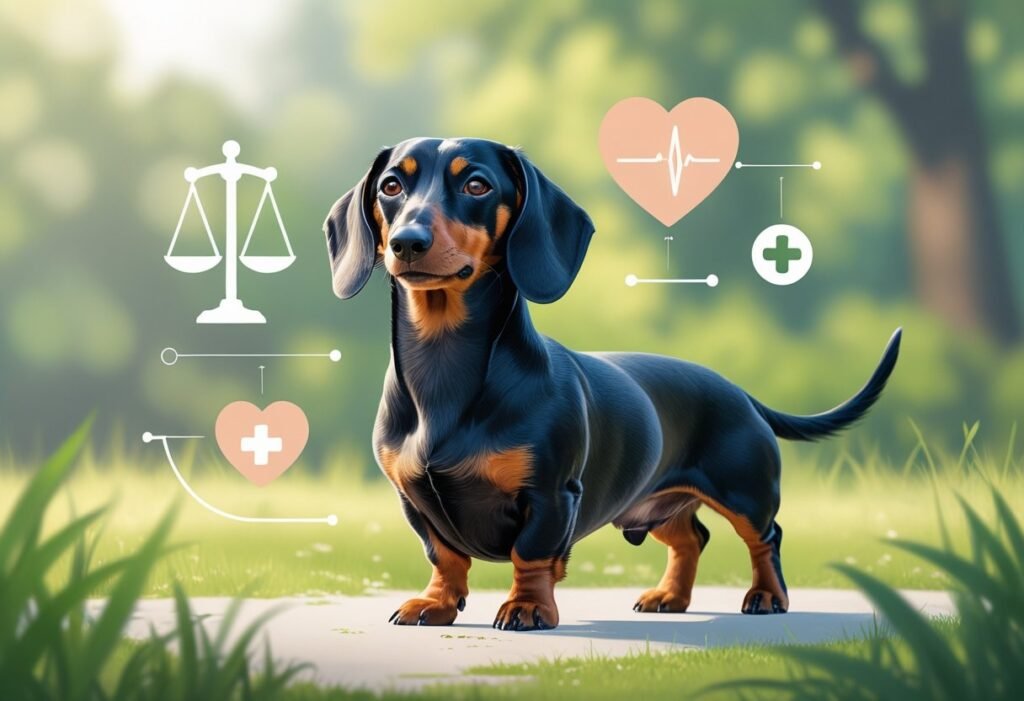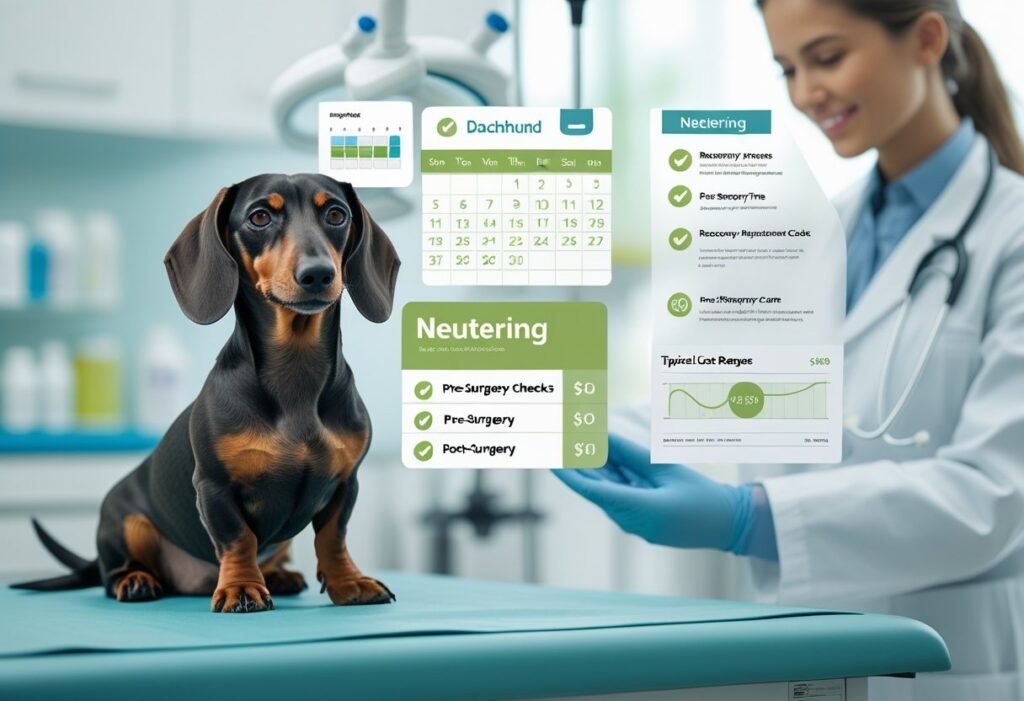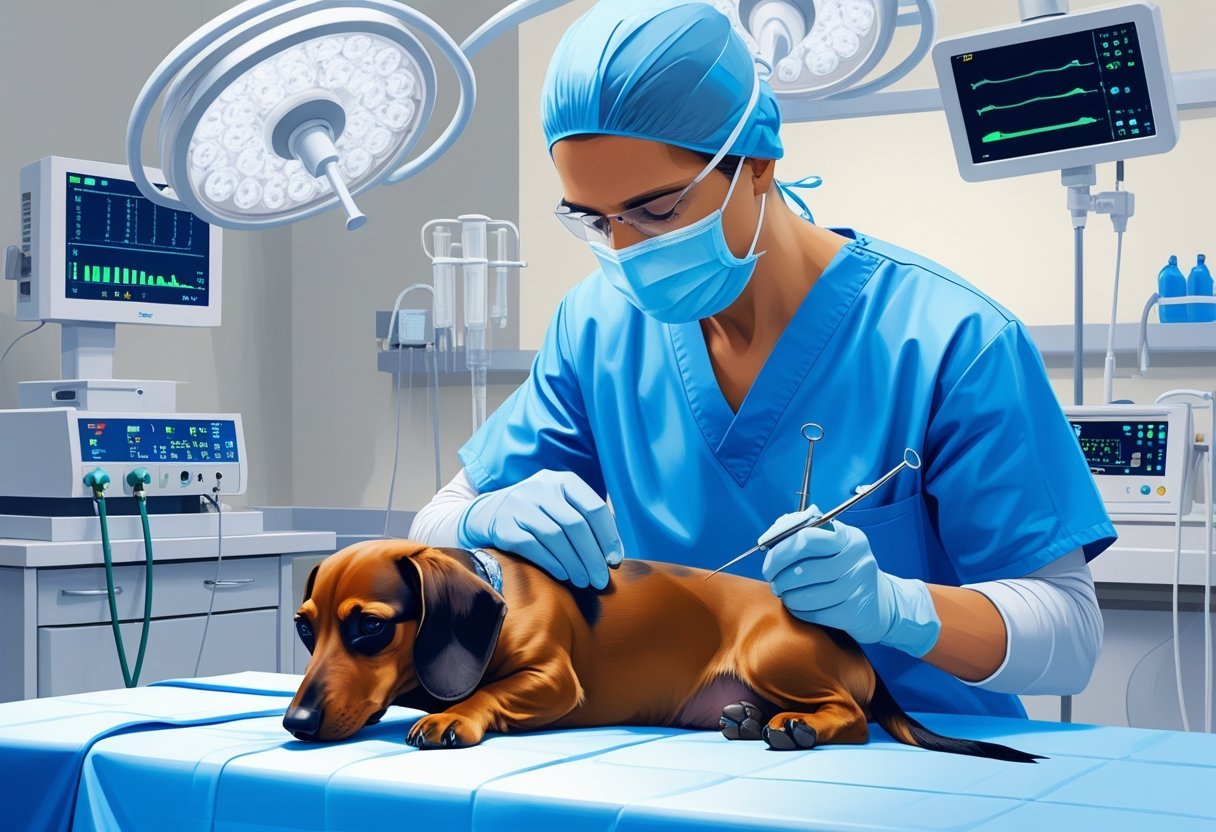Neutering dachshund is a big decision that can shape your dog’s health and behavior 🐾. It helps prevent unwanted puppies and may lower the risk of certain health issues, like some cancers or infections 🩺.
Many people notice it can also reduce behaviors like roaming or marking, which is definitely a plus 🌱.
You might wonder when to neuter your dachshund or what the procedure actually involves 🤔. This post will walk you through what to expect before, during, and after neutering.
We’ll also answer common questions and take a look at some alternatives 💡.
Key Takeaways ✨
- Neutering can support your dachshund’s health and behavior. 🐕
- Timing and recovery are key things to know before scheduling the procedure. ⏳
- There are costs, questions, and choices to consider before deciding. 💰
🐾 Free Dachshund Care Guide
Download our free checklist to ensure your Dachshund stays happy, healthy, and well-loved!
Get Your Free Guide 🐶Understanding Neutering for Dachshunds
Neutering your dachshund is a pretty common veterinary procedure that stops them from reproducing 🐾. It can influence your dog’s health, behavior, and even lifespan 🌱.
It’s good to know why owners choose this surgery and what risks could be involved 💡.
What Is Neutering 🐕🦺
Neutering is a surgical procedure where a vet removes the testicles from male dogs ⚕️. This stops them from fathering puppies and usually reduces hormone-driven behaviors.
The surgery happens under anesthesia, and most vets consider it routine 😌. Afterward, your dachshund will need some time to recover.
Most dogs bounce back to their usual selves within a week to ten days ⏳. The best time to neuter is often between 6 and 12 months old, but your vet might suggest a different age based on your dachshund’s health and growth.

🥗 Wild Earth Vegan Dog Food – Clean, Healthy Nutrition for Your Dachshund
Give your Dachshund gentle, plant-based meals that support long-term health and reduce the risk of sensitive tummy issues.
- 100% plant-based formula for safe, cruelty-free feeding 🌱
- Perfect for Dachshunds with allergies or sensitive digestion 🐾
- Supports strong energy and a balanced weight every day ⚡
Benefits of Neutering Dachshunds ✨
Neutering your dachshund can lower the risk of some health problems like testicular cancer and prostate disease 🩺. It also tends to decrease marking, roaming, and aggression linked to male hormones.
If you have multiple pets, you might notice less fighting or dominance issues 🐾. Neutered dogs are less likely to escape looking for a mate, so they’re safer at home 🏡.

Here are some common benefits:
- Less chance of unwanted litters 🐕
- Reduced risk of some cancers 🩺
- Calmer behavior in most cases 😌
- Lower risk of injury from roaming 🚶
Potential Risks and Considerations ⚠️
Like any surgery, neutering comes with risks—things like infection, bleeding, or an unexpected reaction to anesthesia 💉. Some dachshunds put on weight more easily after neutering, so you might need to tweak their diet or exercise routine 🥗.
Neutering too early can sometimes affect bone growth, so check with your vet about the best timing 📅. It doesn’t fix every unwanted behavior, and it won’t prevent every illness.
Table: Potential Risks and How to Manage Them 📊
| Risk | How to Manage |
|---|---|
| Infection | Follow post-op care instructions; monitor incision 🩺 |
| Weight gain | Control food portions; regular walks 🚶 |
| Behavior changes | Training, toys, socialization 🎾 |
| Hormonal health concerns | Discuss timing with your vet 💬 |
When to Neuter Dachshund
Choosing when to neuter your dachshund depends on age, health, and behavior 🐾. Vets often recommend different timings based on your dog’s size, lifestyle, and risk factors ⚕️.
Recommended Age for Neutering 📅
Most veterinarians suggest neutering dachshunds between six and twelve months old 🐕. The exact timing can vary depending on whether your pup is a miniature or standard dachshund.
Smaller breeds like dachshunds usually mature earlier than big dogs 🌱. For males, neutering typically happens after the testicles have dropped, which is around six months.
Some vets might prefer to wait until eight to twelve months, especially for dogs that are extra active or might benefit from waiting a bit longer 🏃.
Table: Typical Neutering Ages 📊
| Size | Age Range |
|---|---|
| Miniature | 6-9 months |
| Standard | 6-12 months |
Waiting too long can raise the risk of marking, aggression, or accidental litters 🚫. Early neutering may lower the risk of some cancers but can slightly increase the chance of certain joint issues 🩺.

🛡️ The Swiftest Pet Insurance Comparison
- Compare policies that can help with neutering-related costs and emergencies 🐾
- See deductibles, coverage, and exclusions in one place for faster decisions ⏱️
- Pick a plan that supports recovery care and long-term wellness 📋

🥣 ChefPaw Fresh Food Maker
- Create gentle, vet-aligned recipes for post-op tummies and steady energy 🌿
- Control ingredients and portions to support healthy weight during recovery ⚖️
- Batch-cook meals to keep routines simple while activity is limited 📦

Factors Influencing Timing 💡
Your dachshund’s health plays a big role in this decision 🐕🦺. Puppies with health concerns may need to wait until they’re a bit stronger 💪.
If your dachshund has a heart murmur or other medical conditions, your vet will probably suggest holding off ❤️. Behavioral concerns matter too.
Neutering before puberty can sometimes help reduce aggression, marking, and roaming 🐾. Dachshunds prone to anxiety might do better if you wait until they’re emotionally mature 🌼.
Other things to think about: your dog’s living situation, risk of running away, or how likely they are to meet other unneutered dogs 🏡. Always talk with your vet—they’ll help you pick the best time for your dog 💬.
The Neutering Procedure Explained

Neutering your dachshund is a surgical procedure that a veterinarian performs ⚕️. Knowing what happens can help you feel ready and take better care of your dog 🐾.
Pre-Surgical Preparation 📝
Before surgery, your dachshund will get a check-up to make sure they’re healthy enough for anesthesia 🩺. Your vet might ask you to withhold food for 8-12 hours before the operation ⏳.
Usually, water is fine until a few hours before 💧. Bring any medical records and let your vet know about allergies or past issues 📂.
Make sure your dachshund is clean before surgery to help prevent infection 🧼. A short walk is okay, but keep things calm 🌱.
Most clinics need you to sign consent forms and will talk through the risks and benefits 🖊️. The vet team should answer your questions and explain the plan 💬.

😌 Zomalka Homeopathic Anxiety Relief
- Helps ease restlessness and stress during cone time and restricted activity 💤
- Supports a calmer environment for incision healing and crate rest 🏡
- Use alongside vet guidance for a smooth, low-stress recovery 📘

🧬 AnimalBiome Dog Gut Health Test Kit
- Understand your Doxie’s microbiome to guide diet after neutering 🍽️
- Get actionable results you can review with your vet for tailored nutrition 📊
- Identify imbalances that may affect digestion, weight, and energy ⚡
Surgical Process ⚡
The vet uses general anesthesia so your dachshund sleeps through the procedure and feels no pain 😌. They’ll shave and clean the area around the testicles to keep things sterile 🧴.
Then, the vet makes a small cut and removes both testicles ✂️. They tie off blood vessels to stop bleeding and close the skin with stitches or glue.

The whole thing usually takes 20-40 minutes ⏱️. For males, the cut is small and near the base of the penis.
Many clinics use dissolvable stitches, so you might not need to come back for removal ✅. The staff will keep an eye on your dog as they wake up from anesthesia 👀.
Post-Surgery Monitoring 👩⚕️
Your dachshund may feel drowsy for a few hours after surgery 😴. Most go home the same day 🏡.
Here are some important steps after surgery:
- Watch the incision for swelling, redness, or discharge. 🩺
- Prevent licking by using a cone or recovery collar. 🐕
- Limit activity for 7-10 days to avoid injury. 🚫
- Follow your vet’s pain management plan for comfort. 💊
Feed your dog small meals the first night. Call your vet if you notice fever, loss of appetite, or odd behavior. 🍽️
Keep the area dry and skip baths until your vet says it’s safe. 🛁 Most dachshunds recover fully in about 10-14 days 🌼.
Neutering Recovery for Dachshunds

Neutering your dachshund means giving extra care for good healing 🐾. Handling those first days, watching for problems, and supporting your dog’s needs will help a lot 🌱.
Immediate Post-Operation Care 🩺
When your dachshund comes home, keep them calm and cozy 🛏️. Create a quiet spot for rest, using a clean and soft bed away from noise and other pets.
Your dog may feel sleepy or a bit out of it from the anesthesia for a day 😴. Check the incision daily for swelling, bleeding, or redness.
Don’t let your dachshund lick or bite the stitches 🚫. An e-collar, or “cone,” may be needed for about 7–10 days to protect the area.
Keep activity low. No running, stairs, or jumping on furniture ❗ Short leash walks for potty breaks are enough.
If your dog seems nauseous, start with small, bland meals 🍽️. Call your vet if you see pain, pus, fever, or if your dachshund refuses food or water ☎️.

📹 Petcube 360 Cam
- Keep an eye on your Dachshund’s recovery space in real-time 🐾
- Two-way audio lets you soothe your pup from anywhere 🗣️
- Peace of mind while you’re at work or running errands 🏡
📍 Tractive GPS Dog Tracker
- Track your Dachshund’s location during gentle post-op walks 🚶♂️
- Set safe zones and get instant alerts if they wander 🛑
- Waterproof design for any outdoor adventure 🌧️
Typical Recovery Timeline ⏳
Most dachshunds act normal after a couple of days, but healing inside takes longer 🐕. Recovery usually lasts 10–14 days.
Male dachshunds often heal a bit faster than females because the incision is smaller.
A basic recovery timeline:
| Days After Surgery | What to Expect |
|---|---|
| 0–2 | Sleepy, low energy, sore 😴 |
| 3–7 | Slight swelling, still need rest 🩺 |
| 8–14 | Almost back to normal, check stitches ✅ |

🎉 Grab your free Dachshund care checklist!
Vets usually remove stitches or staples about 10–14 days after surgery, unless they’re dissolvable 🧵.
Don’t start normal play or exercise until your vet gives the green light 🟢. Jumping back in too soon can cause injury or slow down healing 🐾.
Managing Recovery Challenges 💡
Jumping and climbing are risky for dachshunds, especially after surgery ⚠️.
Use baby gates or ramps to keep your dog from getting on furniture 🚪. Keep walks short and always use a leash outside.
If your dachshund keeps trying to lick or scratch the wound, try a different style of e-collar or ask your vet about protective clothing 🐕.
Wound care really matters—keep it clean and dry 🧼. Never give human pain medicine unless your vet specifically says it’s okay 🚫.
Look for signs of infection like redness, heat, a bad smell, or pus 👀.
If your dog loses appetite, has trouble breathing, or starts shaking, something’s up ❗ Call your vet if you notice any of these. Better safe than sorry ☎️.
Behavioral and Health Outcomes After Neutering

Neutering dachshunds can change some behaviors and affect their health over time 🐾. Knowing what to expect helps you make better choices for your pet 🌱.
Impact on Behavior 💡
After neutering, your dachshund may feel less urge to roam or escape the yard looking for a mate 🚪. Many owners also see less male marking and mounting behaviors 🐕.
Neutering can sometimes lower aggression toward other dogs, especially if you do it before bad habits set in ⚠️. But it doesn’t guarantee your dachshund will stop barking or become calm in every situation.
Some dachshunds barely change at all. It really depends on the dog and the training you put in 🎾. Regular walks, playtime, and attention still matter for a well-behaved pet ❤️.
Common Behavioral Changes After Neutering 📝
| Behavior | May Decrease | May Stay the Same |
|---|---|---|
| Roaming | Yes 🐾 | |
| Marking | Yes 🚫 | |
| Aggression | Sometimes ⚡ | Sometimes ⚡ |
| Barking | Yes 🐕 |

🍽️ Petlibro Auto Feeder
- Automate feedings to keep meals on schedule during healing ⏰
- Portion control to prevent weight gain after neutering ⚖️
- Stress-free feeding, even when you’re away 🐾

🛏️ Majestic Pet Orthopedic Bed
- Extra joint support for Dachshunds after surgery 💛
- Helps prevent strain from jumping on furniture 🙌
- Cozy design encourages restful, safe healing 🐶

Long-Term Health Effects 🩺
Neutering lowers the risk of testicular cancer and can help prevent prostate problems as your dachshund gets older 🌼.
It might also reduce the chance of some hormone-driven health issues 🧬. Neutered dachshunds often gain weight more easily 🍽️.
Keep an eye on calories and make sure your dog gets daily exercise to stay healthy 🏃.
There could be a slight bump in risk for some joint issues or other health problems, especially if you neuter before your dachshund is fully grown ⚖️.
Talk to your vet about the best timing for surgery based on your dog’s size and development 💬.
Costs and Considerations for Neutering a Dachshund

Neutering your dachshund takes some planning and budgeting 💰. Some choices can change the final cost or how your dog experiences the procedure 🐾.
Expected Costs 💵
The price for neutering a dachshund usually runs from $100 to $300.
The final cost depends on a few things:
- Where you live 🌍
- The type of clinic (regular vet or low-cost shelter) 🏥
- Your dog’s age and health 🐕
- Extra services like pain meds or bloodwork 💉
Low-cost clinics might charge less, but private vets often offer more personalized care 🩺.
Some clinics have special packages that include exams, vaccines, or microchipping 📦. Always ask what’s part of the deal before booking.
Here’s a simple breakdown:
| Expense | Estimated Range |
|---|---|
| Surgery Fee | $100 – $300 💵 |
| Pre-surgery Exam | $25 – $50 🩺 |
| Pain Medication | $10 – $30 💊 |
| Vaccinations (if needed) | $15 – $50 💉 |
Insurance sometimes covers part of the cost, so check your pet policy 📑.
🧾 Everyday Recovery & Care Essentials for Your Dachshund
- 💧 Petlibro Water Fountain — Encourage steady hydration with a continuous flow of fresh water, ideal during recovery.
- 🪜 Majestic Pet Pet-Stairs — Help your Dachshund safely access beds or couches without jumping and straining healing incisions.
- 🎯 Embark Adventure No-Pull Harness — Gentle, secure walks post-recovery without pressure on sensitive areas.
- 🧼 Pride + Groom Grooming Tools Kit — Keep your Dachshund’s coat smooth and healthy with safe, high-quality grooming tools.

Choosing a Veterinarian ⚕️
Pick a vet who knows small breeds like dachshunds 🐾. Ask how many dachshunds they’ve worked with and what steps they take during and after surgery.
If possible, tour the clinic. Look for clean facilities and friendly staff 🧼. Ask about monitoring during surgery and what you’ll need at home for recovery 🏡.
Make sure the vet explains the procedure, possible risks, and all costs before surgery 💬. Request a written estimate and check if the price covers follow-up visits 📄.
If your dachshund has other health problems, find a vet who knows how to handle those during surgery ❤️.
Always use a licensed, reputable clinic or hospital ✅.
Alternative Options to Neutering

Neutering isn’t the only way to manage your dachshund’s health and behavior 🐾. You can look at non-surgical alternatives or compare spaying and neutering to find what fits your pet best 🌱.
Non-Surgical Alternatives 💊
Non-surgical methods help control reproduction and some behaviors without surgery ⚕️.
One option is chemical sterilization. It uses injections or implants to lower fertility 💉. These don’t need anesthesia or recovery time, and sometimes the effects are reversible 🔄.
Hormone treatments are another route. These meds lower a dog’s ability to reproduce, but they can cause weight gain or mood changes ⚠️.
If you use them, your vet should keep a close eye on things 👀.
Managing your dachshund’s environment—like keeping dogs separated by sex and controlling outdoor time—can cut the risk of unwanted breeding 🏡.
Leashes, solid fences, and good supervision go a long way 🚪.
Pros and Cons Table:
| Method | Pros | Cons |
|---|---|---|
| Chemical Sterilization | Non-surgical, sometimes reversible ✅ | May need repeated treatment, side effects ⚠️ |
| Hormone Treatments | No surgery, adjustable ✅ | Side effects, must be monitored 👀 |
| Environmental Control | No medication, no surgery 🌱 | Not always reliable, needs vigilance 🐾 |
💛 Gentle Care & Essentials for a Smooth Recovery Journey
- 🎯 Coastal Harness – Soft, no-pull control for safe, post-surgery walks without strain
- 🌿 Innovet PurCBD Oil – Natural support to ease discomfort and promote calmness during healing
- 📹 Petcube Bites 2 Lite – Check in on your recovering Doxie and reward them with treats while away
- 🛁 King Kanine King Klean Shampoo – Gentle cleanse once your vet approves post-op bathing
- 🎨 Purr and Mutt Dachshund Personalized Art – Celebrate your pup’s journey with a custom keepsake
🐾 Give your Dachshund the care and love they deserve through every step of recovery.

Comparing Spaying and Neutering 🐕🦺
Spaying and neutering are both surgeries, but they’re different ⚡.
Spaying is for female dogs. It removes the uterus and ovaries, so your dog can’t get pregnant ❌.
Neutering is for males, and it removes the testicles to prevent fathering puppies.
Spaying usually takes longer, and the recovery is a bit tougher than neutering ⏳. Neutered males may have less risk of some cancers and show fewer aggressive behaviors 🩺.
Spayed females won’t go into heat anymore, so you won’t have to deal with bleeding or attracting male dogs 🚫.
Not every health problem disappears with these surgeries, but they can lower some risks 🌼.
Here’s a quick comparison:
| Surgery | Used For | Main Effects | Recovery Time | Extra Benefits |
|---|---|---|---|---|
| Spaying | Females | Stops pregnancies ❌ | 10-14 days ⏳ | No heat cycles 🌸 |
| Neutering | Males | Stops reproduction 🐾 | 7-10 days ⏱️ | Less risk of some cancers 🩺 |
Chat with your vet to figure out which option fits your dachshund’s needs 💬.
🐾 Don’t Miss Out!
Download our free Dachshund care guide to keep your furry friend happy and healthy.
Get Your Free Guide 🐶Frequently Asked Questions

Neutering your dachshund can change their health, recovery time, and risk for certain conditions like IVDD 🐾. Costs and behavior changes also play a role in your decision 💰.
What are the potential benefits and risks of neutering my dachshund? ⚕️
Neutering often lowers the risk of some cancers and stops unwanted litters 🐕. It might help with roaming and marking behaviors, too 🚪. There are risks, like reactions to anesthesia or weight gain ⚠️.
Some studies point to orthopedic problems or hormone-related disease changes, but these aren’t common 🩺.
How much is the typical cost for neutering a miniature dachshund? 💵
Most clinics charge between $100 and $300. Prices depend on your location, your dog’s age, and whether you use a private clinic or a shelter 🏥.
You might pay extra for blood work, pain meds, or special care if your dog has health issues 💉.
Can neutering a dachshund affect Intervertebral Disc Disease (IVDD) risks? 🦴
Neutering doesn’t prevent IVDD, which dachshunds sadly get a lot 😞. Some studies say neutering before one year old could raise IVDD risk a bit, but the research isn’t clear-cut 🔬. Ask your vet about the best time for surgery to help lower any IVDD risk 💬.
What should I expect during my dachshund’s recovery from neutering surgery? 🏡
Most dachshunds go home the same day as surgery 🌞. Your dog needs rest and should skip jumping or running for about 10-14 days ⏳. Check the incision daily for redness or swelling 🩺. Your vet will probably recommend a cone to stop licking 🐕. Mild pain or tiredness is normal for a few days 😌.
How might my dachshund’s behavior change after the neutering procedure? 💡
Some dogs get a bit calmer and lose interest in mating behaviors 🌱. Aggression and marking might drop off, but it’s not a sure thing ⚖️. Your dachshund could gain weight after neutering, so keep an eye on their food and exercise 🍽️.
Is there a difference in the cost of spaying versus neutering a dachshund? 💳
Spaying a female dachshund usually costs more than neutering a male 💵. The main reason is that spaying involves a more complicated surgery and takes longer ⏱️.
Spaying can run anywhere from $150 up to $400. Neutering tends to cost less, but prices vary depending on where you live and the size of your dog 🌍.



